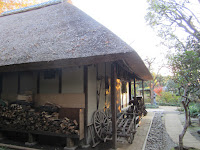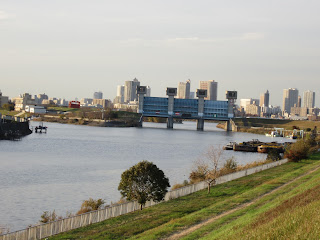I walked the western part of Tokyo Bay (in Tokyo) in my past three walks (see
part 1,
part 2,
part 3). I walked north eastern part of the bay today.
The geography is complicated in the region as there are many artificial islands there. Some are old and some are new. The reclamation works began in the Edo period and continued more than 400 years. The lands have their histories.
I walked along the sea line in the early Meiji Period (1880) today.
>>1880 (early Meiji) sea line
Tsukiji – Tsukudajima Island – Ecchujima – Kiba – Toyo – Minamisuna – Higashisuna – Arakawa River – Kasai
-- The lands reclaimed in the Edo era include:
Hibiya, Tsukiji, Shinkawa, Tsukudajima Island, Ecchujima, Fukagawa, Kiba, Suzaki (Toyo), Sunamura (Minamisuna, Higashisuna), Kasai
-- 1930 (early Showa) sea line
Harumi – Toyosu –Shinonome – Tatsumi – Shinsuna – Arakawa River – Kasai
I started my walk from Tsukiji. Temples and samurai houses stood here in the Edo era and naval facilities were built in the early Meiji era. Now, the place is famous for its fish market.
The last part of Sumida River lies between Tsukiji and Tsukishima, an artificial island developed in the Meiji era. There are modern apartments along the river. The riverside walkway is modern and beautiful. I saw many seagulls in the river.
Tsukudajima Island was developed in the Edo era. Traditional shops of tsukudani, or traditional seafood boiled in soy source, attracted visitors.
I walked eastward from Ecchujima to Kiba. The areas were first used as agricultural fields and residential areas in the Edo period. They turned into industrial areas after the Meiji period. Canals flow here and there.
I found an old ship named “Meiji maru” displayed in the ground of Tokyo University of Marine Science and Technology.
I walked eastward and arrived in Toyo. There are many huge residential apartments along the main street. Some of them have more than 500 houses in each building. I got the impression that the towns were artificial and dry.
I arrived at Arakawa River. The lower part of the river was artificially developed in the early 20th century (1913-30) to prevent water flood. The river was wide and plenty of water flew down to the sea.
Power cables run over the river. The lines of transmission towers were beautiful in the sunset.
.JPG)
.JPG)
.JPG)
.JPG)
.JPG)
.JPG)
.JPG)
.JPG)
.JPG)
.JPG)
.JPG)
.JPG)
.JPG)
.JPG)
.JPG)
.JPG)
.JPG)
.JPG)
















.JPG)
.JPG)

.JPG)
.JPG)
.JPG)
.JPG)













